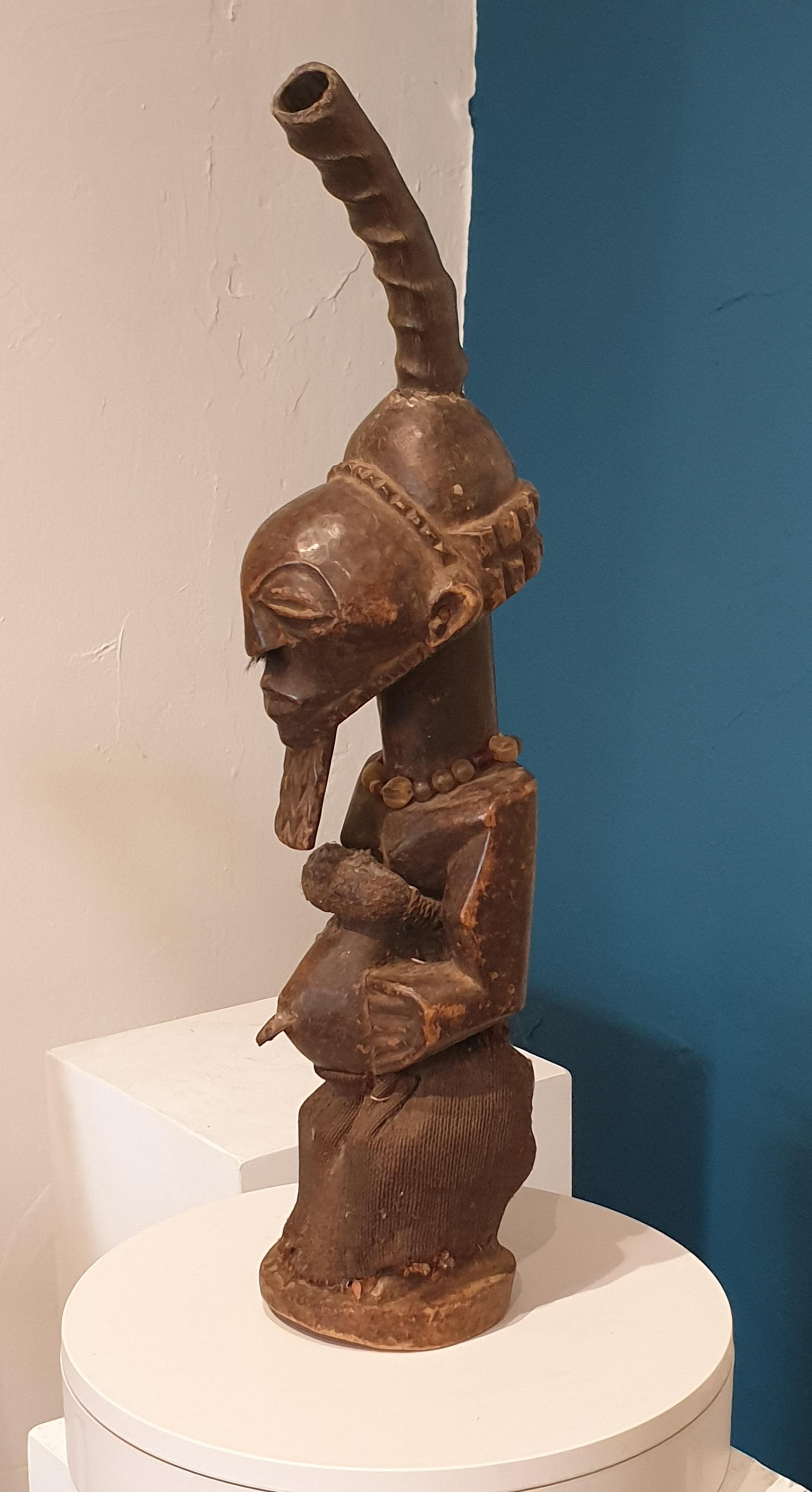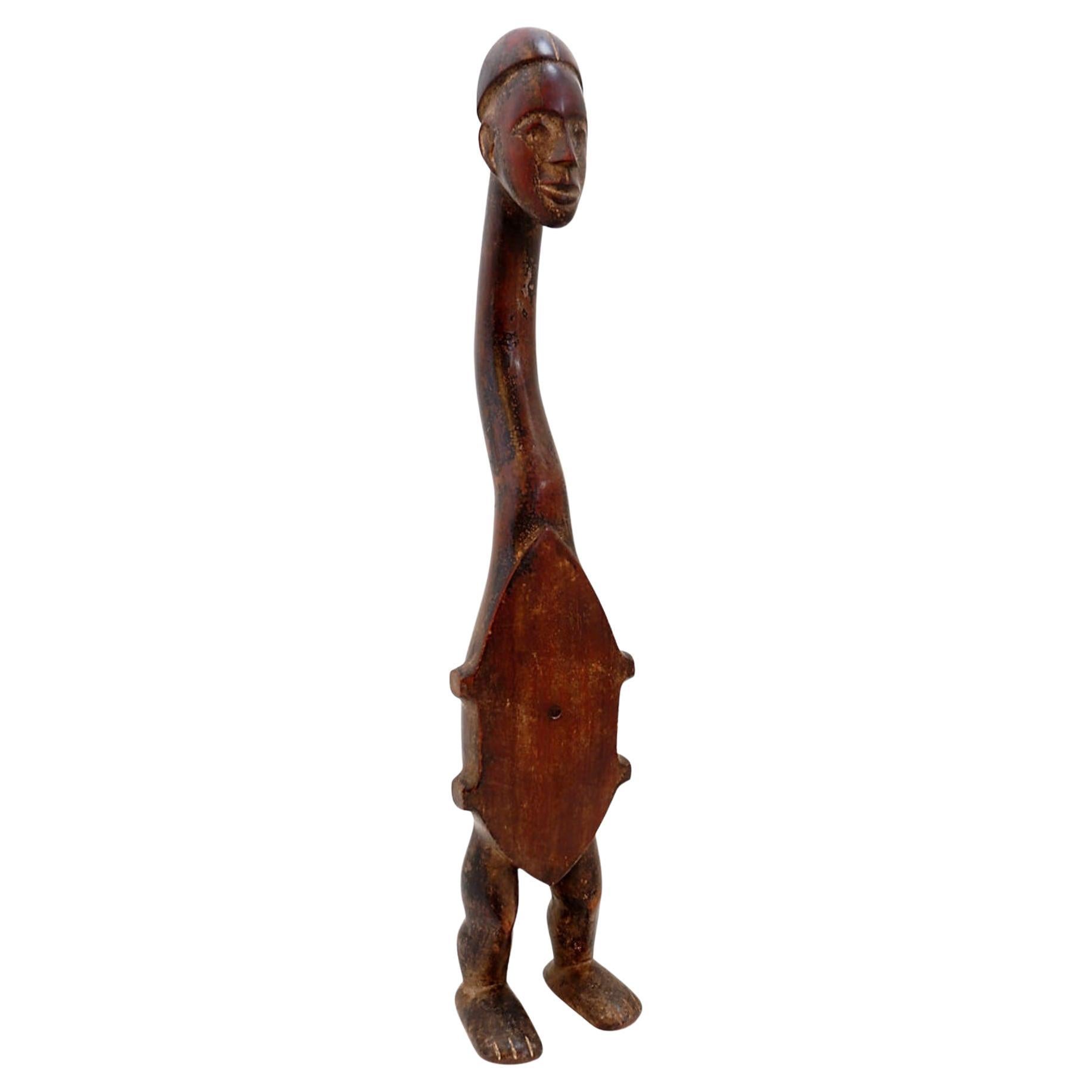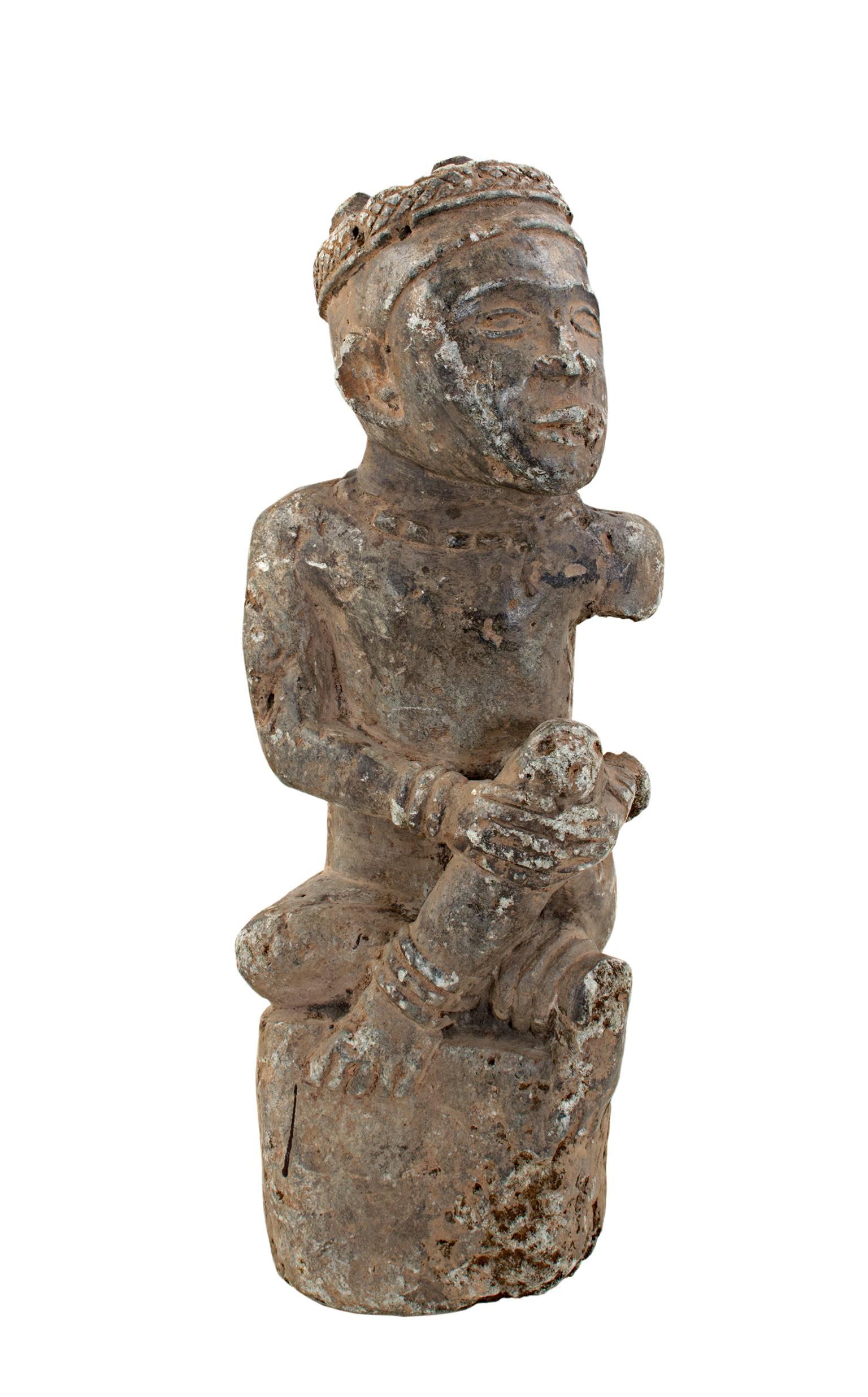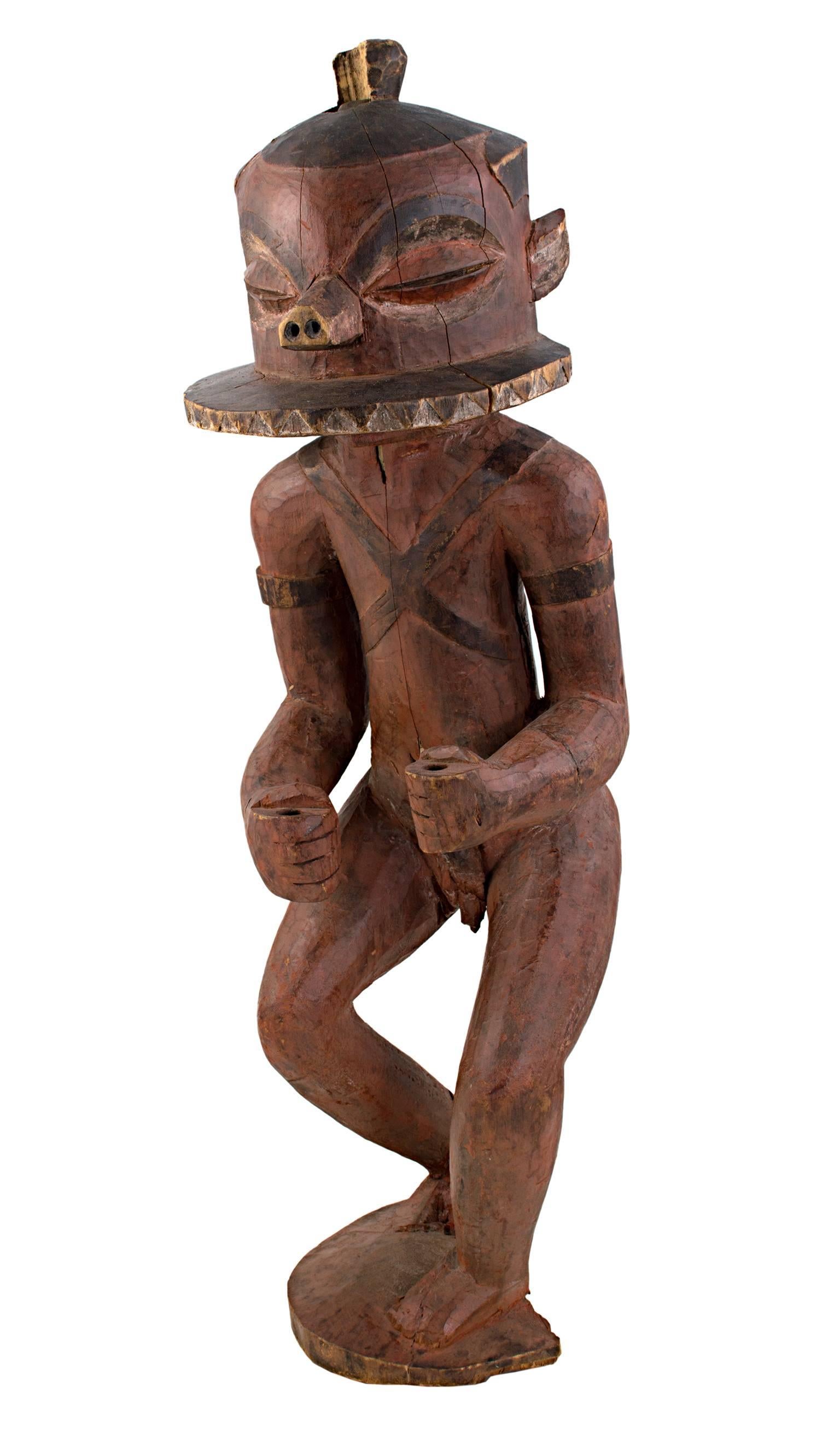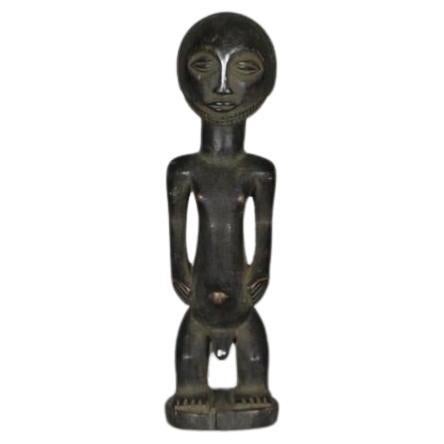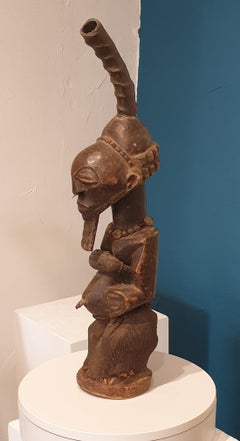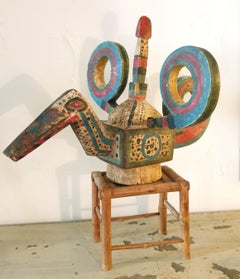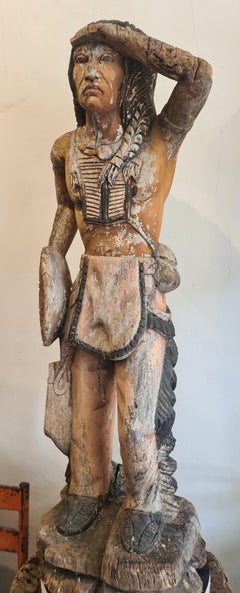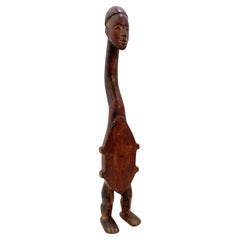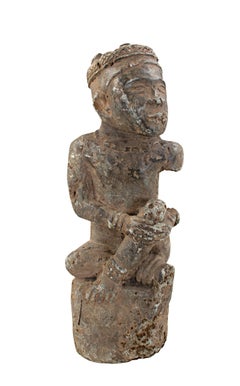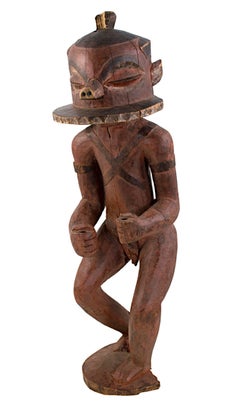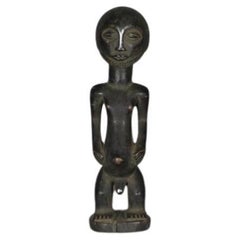Items Similar to Statue Songye, Kneeling Male Figure, Democratic Republic of Congo
Video Loading
Want more images or videos?
Request additional images or videos from the seller
1 of 22
Songye CraftsmenStatue Songye, Kneeling Male Figure, Democratic Republic of Congo
$3,645.50
$4,556.8820% Off
£2,711.89
£3,389.8620% Off
€3,040
€3,80020% Off
CA$4,991.94
CA$6,239.9320% Off
A$5,550.36
A$6,937.9520% Off
CHF 2,898.09
CHF 3,622.6120% Off
MX$67,561.39
MX$84,451.7420% Off
NOK 36,978.39
NOK 46,222.9820% Off
SEK 34,646.98
SEK 43,308.7320% Off
DKK 23,141.84
DKK 28,927.3020% Off
Shipping
Retrieving quote...The 1stDibs Promise:
Authenticity Guarantee,
Money-Back Guarantee,
24-Hour Cancellation
About the Item
A Songye Male Power Figure, Democratic Republic of the Congo, the male figure resting on one knee, with openwork arms and hands resting by the abdomen which contains various charms and hand forged items, carrying on his back a bound 'hote'. Typical facial features. Fine medium and dark brown patina with encrustation.
Provenance: the figure has been in the collection of a Danish Cineaste since the 1960s.
Similar figures are held in The Metropolitan Museum of Art and the Royal Museum for Central Africa in Tervuren.
Acting as a mediator between spirits and men, Songye mankishi statues were made to heal, protect, bring luck and fertility. While small ones, such as ours, were reserved for personal use, large statues were intended to protect the entire community, often for generations. The communal nkishi was placed under the protection of a guard, who was supposed to translate the messages of the nkishi under the influence of mediumistic possession. It is possible to see the talents of the sculptor and soothsayer (nganga) that are expressed in the creation of the statue. The latter makes the magical components (bishimba) placed here, in the stomach area and at the top of the head. The effectiveness of these medicines will determine the value and power of nkishi. Covering the statue with palm oil ointment and filling the head with a wide variety of materials charged the statue and gave it all its magical power. The skin of our sculpture is now drowned under layers of oil, witness of prolonged use over several generations. The perfection of the geometric composition and the sensitivity of the models are translated here by the hand of a very great sculptor.
Reserved for the personal use of an individual or a family, this Nkisi statuette was intended to heal, protect, bring luck and / or fertility. The strength of the sculpture characterizing the style of the workshops of Bena-Sapo (Luebo region) is accentuated by the magico-religious additions recalling its role as mediator between men and spirits.
THE CHARMS OF GOOD FORTUNE
by Bernard Dulon
Among the many bwanga or fetishes once used by the nganga (clairvoyants, traditional spiritual healers) of the Songye people, there is a specific type that earned a place of choice for itself among the icons of Central African art: mankishi (singular: nkishi). They are anthropomorphic statues to which bishimba, or magically significant ingredients, were ritually attached: generally inserted into the navel or top of the head.
Mankishi can be divided into two categories: personal mankishi and community mankishi. The examples from the second category, including the one from the Périnet collection, are characteristically large. They were not statues of ancestors, strictly speaking, but rather intermediaries between living people and the most venerable among the deceased: honourable chiefs and prestigious notables. They also played an important role in the group’s fertility and the reincarnation of beneficial spirits, protection and healing, resistance to evil witchcraft, and success in combat.
Community mankishi were crafted by a sculptor and made sacred by a nganga through a very special ritual observed in different locations throughout Songye country. When the statue was fully sculpted, it would be placed near a fire by night, the Nganga was the only entity authorised to remain in the village during this operation, in order to invite the spirits to come warm themselves and to foster the divination practices for the consecration of the bishimba and the transformation of the sculpture into a nkishi. The nganga believed to have the powers necessary for this activation were uncommon, and their services were very expensive. Certain mankishi, closely related to their nganga, could go into decline following the death of the healer. They would become useless and be abandoned.
The community nkishi was kept in a sanctuary guarded by a nkunja, who could be an old man or an old woman. Through trances or dream visions, the nkunja received messages from the forces expressing themselves through the nkishi and passed them along to the village.
During new moon ceremonies, the great nkishi was taken out, and could be placed on a chief ’s throne. It was given libations of palm oil and blood, as well as rooster meat, as offerings for the ancestors to recharge its forces. During this ceremony, those who possessed personal mankishi could bring them so that they too could benefit from the replenishment.
A number of historical sources indicate that the Songye were particularly renowned for their knowledge in the art of mankishi, and that certain great examples were used by foreign populations outside of the Songye territory.
The opulent nkishi of the Périnet collection stylistically belongs to the Songye-Kalebwe region. The features of its harmonious face evoke those of the most extraordinary masks of the bwadi-bwa-kifwebe fraternity. It is true that in this region, during the nocturnal replenishment ceremony of a great nkishi, these masks were also brought out, since they were thought to hold a form of beneficial magic called buci.
According to certain theories, the horn or horns that appear at the top of the head or in the abdomen of a nkishi are not so much bishimba as independent bwanga which reinforce the power of the nkishi.
A nkishi could be personally named after one of the important people of the past.
- Creator:Songye Craftsmen (African)
- Dimensions:Height: 18.9 in (48 cm)Width: 4.73 in (12 cm)Depth: 7.88 in (20 cm)
- Medium:
- Period:
- Condition:Wear commensurate with age and use.
- Gallery Location:Cotignac, FR
- Reference Number:Seller: LG/Songue21stDibs: LU1430213108262
About the Seller
5.0
Platinum Seller
Premium sellers with a 4.7+ rating and 24-hour response times
Established in 2000
1stDibs seller since 2020
248 sales on 1stDibs
Typical response time: <1 hour
- ShippingRetrieving quote...Shipping from: Cotignac, France
- Return Policy
Authenticity Guarantee
In the unlikely event there’s an issue with an item’s authenticity, contact us within 1 year for a full refund. DetailsMoney-Back Guarantee
If your item is not as described, is damaged in transit, or does not arrive, contact us within 7 days for a full refund. Details24-Hour Cancellation
You have a 24-hour grace period in which to reconsider your purchase, with no questions asked.Vetted Professional Sellers
Our world-class sellers must adhere to strict standards for service and quality, maintaining the integrity of our listings.Price-Match Guarantee
If you find that a seller listed the same item for a lower price elsewhere, we’ll match it.Trusted Global Delivery
Our best-in-class carrier network provides specialized shipping options worldwide, including custom delivery.More From This Seller
View AllStatue Songye, Republic of Congo, Misangu Glass Beads & Chiefly Raffia Skirt
Located in Cotignac, FR
A Songye Male Power Figure, Democratic Republic of the Congo, the male figure with openwork arms and hands resting on the abdomen, typical facial features and a waterbuck (kobus elli...
Category
Mid-20th Century Tribal Figurative Sculptures
Materials
Metal
$11,512 Sale Price
20% Off
African zoomorphic puppet head sculpture from the Bozo Tribe in Mali.
Located in Cotignac, FR
Early 20th century zoomorphic African puppet head sculpture from the Bozo tribe in Mali.
This puppet head would have been used by the Bozo ethnic group during the Sogobo ceremony.
This ancestral tradition continues in the region of Segou in Mali along the Niger river. It is an opportunity to regroup the different villages and give rise to musical and theatrical performances whose highlight is the puppet show...
Category
Mid-20th Century Figurative Sculptures
Materials
Metal
Kalao (Great Hornbill) Ibibio Wooden Sculpture, Nigeria.
Located in Cotignac, FR
Mid-Century Ibibio wood carving of a Great Hornbill or (Kalao) from Nigeria. (The carving is shown in the first photo on a bamboo stand which is available if required.)
The Great Ho...
Category
Mid-20th Century Sculptures
Materials
Wood, Paint
Cigar Store Indian, Early 20th Century, Carved Wood With Polychrome Decoration
Located in Cotignac, FR
A 20th Century wood carved male figure, a 'Cigar Store Indian' with original polychrome decoration.
A now controversial subject, but none the less charming rendition, of a native North American man originally probably used as an advertising figure. Wonderful quality of carving capturing the stance of the man looking out to the distance, hair flowing to his back and plait to the side, all the details of his costume, his native dress and hairpipe breastplate (suggesting he is possibly a Comanche) and chest ornament, apron, trousers, mocassins, shield and arrows. The original Polychrome decoration has weathered beautifully as has the wood itself to present a sculpture that would adorn any collection or interior.
Because of the general illiteracy of the populace, early store owners used descriptive emblems or figures to advertise their shops' wares. American Indians and tobacco had always been associated because American Indians introduced tobacco to Europeans. As early as the 17th century, European tobacconists used figures of American Indians to advertise their shops.
Because European carvers had never seen a Native American, these early cigar-store "Indians" looked more like Africans with feathered headdresses and other fanciful, exotic features. These carvings were called "Black Boys" or "Virginians" in the trade. Eventually, the European cigar-store figure...
Category
Mid-20th Century American Realist Figurative Sculptures
Materials
Wood, Paint
$3,175 Sale Price
44% Off
Mid-Century Nude Male Acephale Sang de Boeuf Ceramic Sculpture with Marble Base.
By Franta (Frantisek Merte)
Located in Cotignac, FR
French Mid 20th Century ceramic figure of a man in Sang de Boeuf, oxblood red, glaze presented on a metal 'tige' and marble base.
The sculpture is not signed but was purchased from ...
Category
Mid-20th Century Abstract Expressionist Nude Sculptures
Materials
Marble
Watercolour on Handmade Paper Laid on Vélin d'Arches of an African Sculpture.
By La Roche Laffitte
Located in Cotignac, FR
Watercolour on handmade paper possibly of a 'Fang' figure applied to Vélin d'Arches paper by French artist La Roche Laffitte.
A beautifully observed and detailed study of a Fang figure in muted brown on high quality hand-made paper. An extremely chic and elegant watercolour.
This contemporary artist, born in 1943, specialises in watercolour studies on hand-made paper. With his highly detailed and precisely painted studies he invites us into the magical world of cultural objects, flora and fauna. The treasures of nature along with tribal regalia is his main inspiration. All of his work is beautifully observed and executed down to the smallest detail.
The Fang are a major ethnic group of Central and West Africa and form part of the population of Gabon, Equatorial Guinea, and Cameroon.
They produce monumental anthropomorphic wooden statues, used for ritual purposes, with an aesthetic that was admired from the late nineteenth century onwards by such famous modern artists as Pablo Picasso, Georges Braque, and André Derain.
Fang sculptures...
Category
Late 20th Century Realist Figurative Drawings and Watercolors
Materials
Watercolor, Handmade Paper
You May Also Like
Traditional sculpture originating from the Democratic Republic of Congo
Located in Linkebeek, BE
Traditional sculpture originating from the Democratic Republic of Congo
Tribal Art - Congo - African
Measures : 16x17cm H:82cm
Traditional sculpture from the Democratic Republic of ...
Category
Early 20th Century African Tribal Figurative Sculptures
Materials
Wood
"N'Tadi King - Zaire, " Carved Cothe Stone Sculpture created between 1800-1850
Located in Milwaukee, WI
This sculpture was created out of cothe stone to represent the king of the N'Tadi tribe in Zaire. This tribe is now called Pende. The sculpture stands 15 1/2" x 6" x 5 1/2".
The Pe...
Category
19th Century Folk Art Figurative Sculptures
Materials
Stone
"BaPende Statue - Zaire, " Carved Wood Sculpture created in Africa circa 1940
Located in Milwaukee, WI
This statue was carved by an unknown Pende artist from Zaire. It depicts a walking man with a disc-shape on his head and large eyes.
25 3/4" x 7" sculpture
The Pende people are an...
Category
1940s Folk Art Figurative Sculptures
Materials
Wood
Small Carved Wood 'Luba' Statue, Congo
Located in Washington, DC
Hand-Carved Wood 'Luba' Fertility Statue. Democratic Republic of the Congo, circa 1970.
Category
Vintage 1970s Congolese Tribal Figurative Sculptures
Materials
Wood
Important Statue Of The Yaka Tribe, Dr Congo, early 1900
Located in Bilzen, BE
Important statue of the Yaka tribe, DR Congo from the beginning of the 20th century with a strong expression
Fair tribal patina
Height 35.5 cm
Provenance: Rob Vervoort (Belgium)
Category
Early 20th Century Congolese Tribal Tribal Art
Materials
Wood
Guine Statue Of The Kusu Tribe, DR Congo, First Half Of The 20th Century
Located in Bilzen, BE
Genuine carved wooden statue of the Kusu tribe DR Congo, first half of the 20th century with a tribal aged patina of use
Height without nail on the head 20 cm
Category
Vintage 1930s Congolese Tribal Tribal Art
Materials
Wood
More Ways To Browse
Large Male Sculpture
Democratic Republic Of The Congo
Male Statue
Statues Of Male
Head Male Sculpture
Male Metal Sculpture
Congo African Art
Congo Sculptures
African Statues
Kneeling Woman
Wood Kneelers
Used Fire Guard
Moon Face Vintage
African Throne
Guard Statue
Moon Statues
Kneeling Woman Sculpture
Large African Statue
